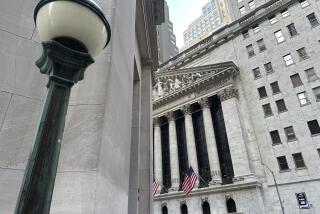Market Watch : Little Guy Played Big Role
- Share via
Faster than you can clip a bond coupon, the terror over rising interest rates has suddenly subsided. You can thank a lot of small investors--and hope they’re right in their judgment.
Last week’s $30-billion Treasury financing went far more smoothly than Wall Street expected, mainly because individual investors were elated at the idea of getting 8.4% to 8.6% yields on Uncle Sam’s 3-year, 10-year and 30-year notes and bonds. And there’s a lesson in that for the future.
How hungry were investors? Bond trader Charles Ovis at Bateman Eichler, Hill Richards in Los Angeles says he saw “very good demand from mom-and-pop accounts” for the 3-year and 10-year securities. At A. G. Edwards & Sons, a St. Louis-based brokerage that is a big name throughout the nation’s heartland, bond trader James Hodapp says he saw “much more demand by individuals than at any time since last spring.”
Although many analysts had worried that the government would have to pay sharply higher rates to sell its notes and bonds, the run-up in rates that had taken place in January turned out to be enough. And the euphoria carried into Friday, when buyers continued to pour into the Treasury market, fueling a tremendous rally. While the government sold its 30-year bonds at an average yield of 8.50% on Thursday, by Friday the demand for the bonds was so strong that the yield had tumbled to 8.33%.
Clearly, analysts had been overly preoccupied with whether Japanese buyers would bid for the securities. The experts overlooked the American investor’s point of view: Rates on short-term investments, such as money market funds, are no longer very attractive; high-yield junk bonds have become Untouchables, and the stock market looks too risky. That leaves few options for your money.
Six months ago, the average money market mutual fund yield was 8.33%. The yield on 30-year T-bonds was 8.05%. So who needed long-term bonds then? Now, the average yield is just 7.66%. So 8.50% on a long-term bond is a big incentive to invest.
Long-term interest rates in the United States jumped in January largely because rates in West Germany and Japan had jumped. Many analysts worry that German and Japanese rates will head even higher soon, given the booming economies of those nations. The fear is that long-term rates here will follow. But the Treasury auction suggests that any rise in rates would quickly bring out a herd of bond buyers and that rates here wouldn’t stay up for long. If so, that would be good news for the housing market, the stock market and the economy in general. Stay tuned.
THE SAVER’S CHOICES
Investment 6 mos. ago Now Money market fund 8.33% 7.66% 6-month bank CD 8.27% 7.88% 1-year bank CD 8.25% 7.95% 10-year T-note 7.97% 8.30% 30-year T-bond 8.05% 8.33%
Money fund and CD yields are national averages.
Sources: IBC/Donoghue’s; Bank Rate Monitor
Sutro’s Challenge to Brokers: The misfortunes of the nation’s major New York-based brokerages create great opportunities for regional firms in Los Angeles and elsewhere in the 1990s, says Lloyd Greif, vice chairman of Sutro & Co. In fact, Greif told a conference of regional brokerage executives in San Francisco last week that the decade is theirs to grab.
“The 1980s clearly belonged to the national securities firms because they were the ones that put together the mega-mergers, the billion-dollar-plus hostile takeovers,” said Greif, who runs Sutro’s corporate finance arm from Los Angeles. “These major transactions will be fewer and farther between in the 1990s. . . . But the middle-market deals, those of $250 million and less, are continuing to get done,” Greif said, because they don’t require the junk bond financing that big deals required. While most mega-deals were engineered in New York, middle-market deals tend to originate outside New York, on regional brokerages’ turf, Greif said. And Los Angeles, he said, “is the middle-market capital of the U.S., if not the world.”
Greif isn’t talking about hostile takeovers when he uses the word “deal.” Most middle-market corporate deals are cases of smaller firms making friendly purchases of others; family-owned firms that have opted to sell, or entrepreneurs looking for financing. Despite the generally sorry state of the brokerage business, Sutro’s backlog of work in those deal areas is bigger than at any time in the ‘80s, Greif said. “We’re hiring,” he said.
To keep clients happy in the 1990s--and to lure new clients--Greif said regional brokerages have to think bigger. In particular, he said, regional firms have to think internationally, because that’s the way smart corporate clients and individual investors will be thinking. And he also warned that “California (brokerages) can’t focus just on the Pacific Rim, and East Coast firms can’t concentrate only on Europe. Firms must look at the market on a global basis.”
Briefly: For small-stock fans, the National Assn. of Securities Dealers offers a directory of 4,300 over-the-counter firms. It includes address, phone number, stock symbol and an investor contact for each firm. Price: $10. Send check or money order payable to NASD, plus a shipping label, to: NASD Inc., Book Order Dept., P.O. Box 9403, Gaithersburg, Md. 20898-9403 . . . In an uncertain stock market, Smith Barney, Harris Upham tells clients to refocus on the basics. “Look for companies and industries that are likely to have pricing power in the 1990s.” That means industries where capacity is tight, even in this slow economy. “Natural gas producers are an example,” the brokerage says.
More to Read
Inside the business of entertainment
The Wide Shot brings you news, analysis and insights on everything from streaming wars to production — and what it all means for the future.
You may occasionally receive promotional content from the Los Angeles Times.










